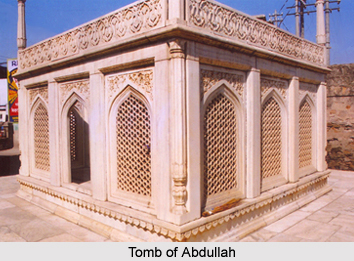 Tomb of Abdullah was built in 1704 A. D. by Syed Abdullah Khan in the city of Ajmer in Rajasthan. The ancient building was constructed in a location that is presently a part of Kaisarganj Mohalla. Abdullah Khan also known as Miyan Khan was the father of the Sayyid Brothers of later Mughal period. He stayed in Barha in the United Province and served as a Subedar of Ajmer during the reign of Emperor Aurangzeb. Other than this building, he had also constructed several other buildings and gardens in Ajmer. Later the place, where he had built the buildings and gardens, was named as `Abdulla Ganj.`
Tomb of Abdullah was built in 1704 A. D. by Syed Abdullah Khan in the city of Ajmer in Rajasthan. The ancient building was constructed in a location that is presently a part of Kaisarganj Mohalla. Abdullah Khan also known as Miyan Khan was the father of the Sayyid Brothers of later Mughal period. He stayed in Barha in the United Province and served as a Subedar of Ajmer during the reign of Emperor Aurangzeb. Other than this building, he had also constructed several other buildings and gardens in Ajmer. Later the place, where he had built the buildings and gardens, was named as `Abdulla Ganj.`
Architecture of Abdullah"s Tomb
Tomb of Abdullah Khan is located on the reverse side of the tomb of Begam of Abdullah Khan. The building is quadruple and comprises of a small court with the tomb surrounded by marble screens by means of a parapet. A railing was earlier present along the platform that has now disappeared. The tomb`s cenotaph decorated with fine carved screens has been kept open and has no inscriptions engraved on it. The central arch has been embellished with stone lotus flowers on the upper side of the corners. The two beautiful minarets are also worth noticing here.
The tomb has been built on a platform enclosed by a plinth. It"s almost 3 feet above the ground. The square chabutra that sustains the grave measures about 35 feet each side. The columns at the four corners are octagonal in shape. Polished white marble has been used for constructing the complete structure excepting the inner portion of the dome which has been plastered. The four `chatries` located at the four corners of the building are imposing. The tomb has been built in the midst of an inner square. At the four corners there are small piers and half columns decorated with arches between them. An inscription has been engraved on a marble slab, which was built on the northern side of the arch. It states about the date of its construction i.e. 1710-11 A. D. in 1715 A. D.
Mosque in the Tomb of Abdullah
Behind the Tomb of Abdullah Khan, a mosque has been built on the western side. An inscription has been engraved in Persian language that states that the mosque had been constructed under the patronage of Syed Abdullah Khan and was supervised by Danish. The mosque has been built in the centre of a garden that was laid by Syed Abdullah Khan. He had also made a water channel in this garden from the Ana Sagar Lake.
In memory of his deceased Begum, Syed Abdullah Khan also built a `maqbara` in this garden. He then surrounded it with compound wall and its remains are still visible. It has now been fixed in the wall of the mosque. According to an inscription, the mosque and the garden were built together alongside the tomb between 1702 and 1704 A. D. The exquisite gateway of the mosque resembles the fort of Akbar. According to history, Hussain Khan had ordered for the construction of the gateway while returning from Merta and traveling towards Deccan via Ajmer. Husain Ali Khan was bestowed with the title of Amir-ul-Umara by Farrukh Siyar in 1712 A. D. He was later assassinated by Mir Hyder at Toda while he was returning from Merta in September 1720. The body was taken to Ajmer and was buried in the compound of Tomb of Abdullah Khan.
The Tomb of Abdullah Khan is regarded as one of the most exquisite buildings of the Mughal period and closely resembles the Solah Khamba or the tomb of Shaikh Alauddin. This miniature building depicts the excellent craftsmanship of the artisans of the Muslim period.



















